Learn how to make this red cabbage sauerkraut recipe at home. It uses just 3 ingredients and is great for gut health. Never buy this fermented side dish from the store again!

I wish I'd known sooner how easy it is to make my own red cabbage sauerkraut.
Requiring just 3 ingredients (cabbage, salt and water), all you have to do is leave the mixture on a countertop to ferment for a few days and that's it!
You'll end up with a lightly tangy, savoury and salty sauerkraut that goes great in a vegan grilled cheese sandwich.
It tastes much better than store-bought versions and doesn't have that strong vinegary taste.
The best part? This quick red cabbage sauerkraut recipe doesn't require any cabbage massaging or sauerkraut burping (as I don't ferment with a lid on).
What is fermentation?
In simple words, fermentation is the breakdown of a substance into a simpler substance.
This breakdown is usually performed by yeasts, bacteria or other microorganisms.
In this process, cabbage is converted to sauerkraut due to growth and acid production by a succession of lactic acid bacteria.
I learned this method of lacto-fermentation from a nutritionist I worked with several years ago, and I just love how simple the process is.
Health benefits of eating sauerkraut
Naturally fermented sauerkraut is really healthy.
It's rich in probiotics (beneficial live bacteria) as a result of fermentation.
Red cabbage also contains a good amount of vitamin C, fibre, and minerals like iron and copper.
Eating sauerkraut is an easy way to get those good bacteria that strengthen the overall immune system.
Red cabbage in particular also has higher amounts of many nutrients than white or green cabbage, which is why I've chosen to use it.
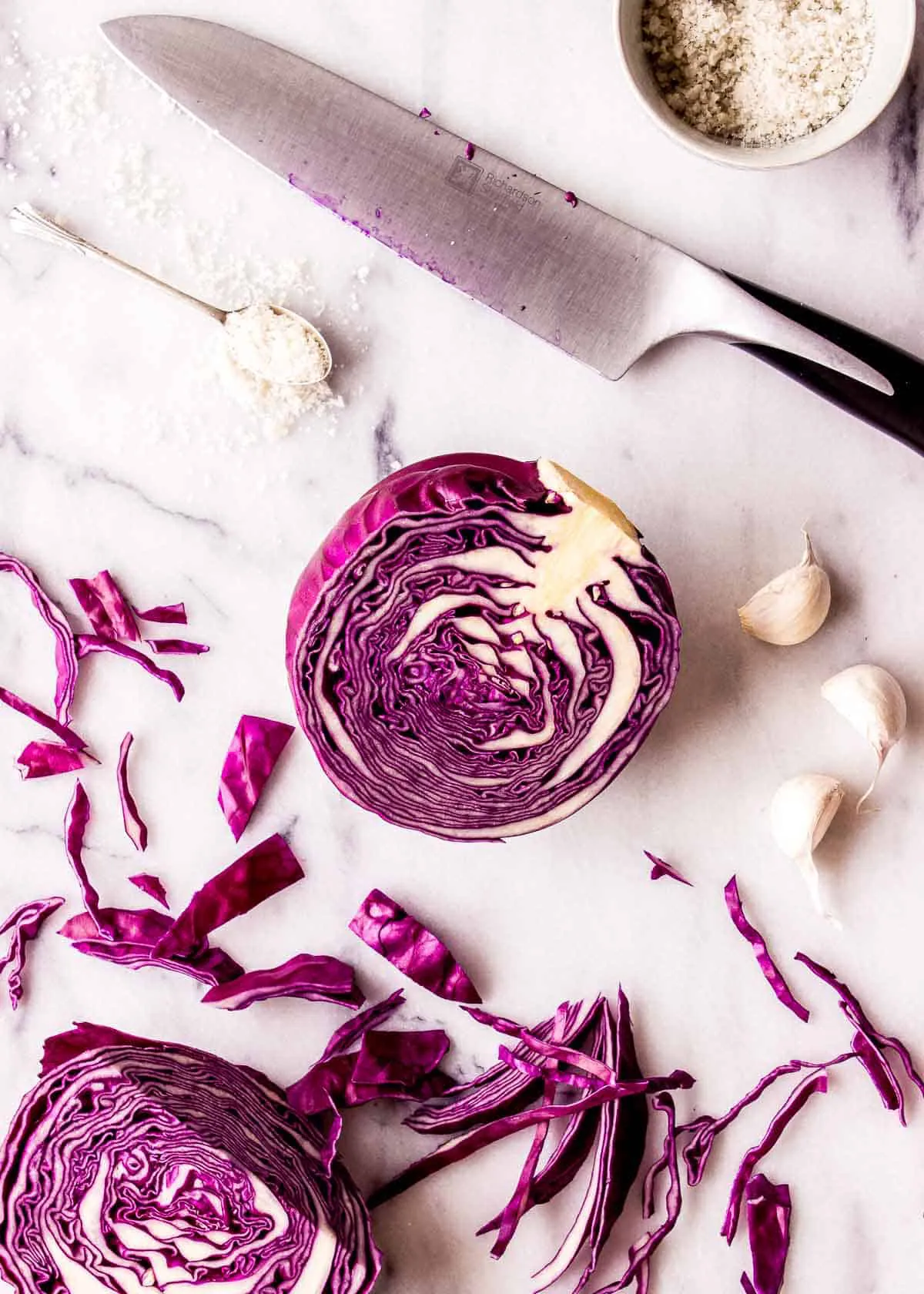
What you'll need
Red cabbage - The star ingredient. Sometimes called purple cabbage. A great place for lactic acid bacteria to grow (that works magic in fermenting sauerkraut!).
Salt - Use fine ground sea salt as you're mixing it into water and don't want to make that more difficult by using coarse!
Salted water or brine preserves the cabbage dish while preventing unwanted growth that can interfere with the fermentation process.
Water - Filtered water, ideally, to avoid the introduction of other substances as the kraut ferments.
1 litre/32 oz mason jar or glass jar with lid - Make sure it's really clean so you don't end up with any bad bacteria during fermentation.
You can also a specialized fermentation vessel like a fermentation crock if you've been in the home fermentation game for a while now.
How to make red cabbage sauerkraut
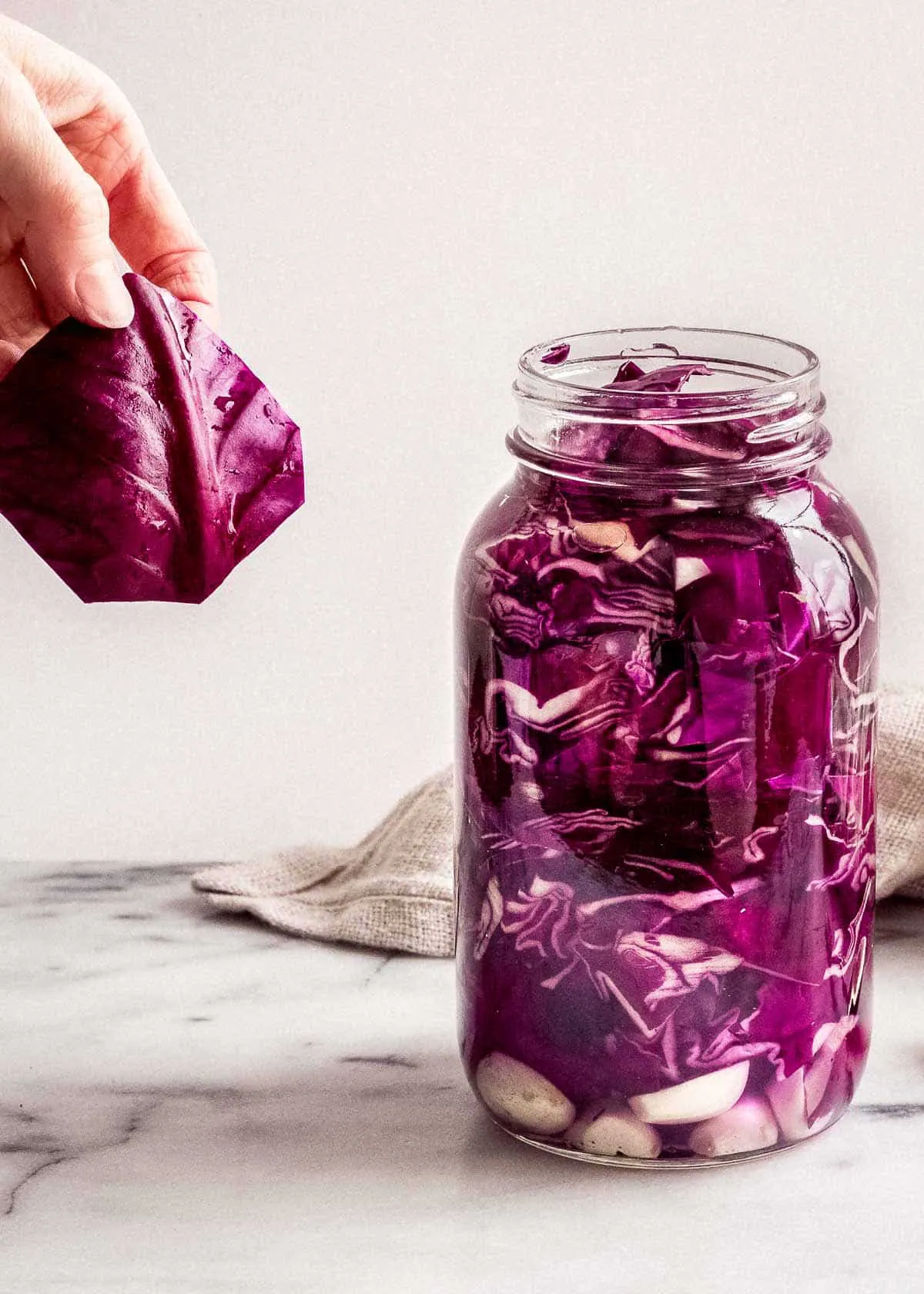
1) Ensure your mason jar is totally clean by sanitizing or washing it in hot soapy water.
2) Set aside one piece of cabbage that's slightly larger than the mouth of the mason jar (this is what we'll use to cover the rest of the cabbage).
3) Slice the rest of the cabbage thinly. Aim to make each piece similar-sized, so they all ferment at the same speed.
4) Place the sliced cabbage in the jar, pressing it down tightly to cram as much in as possible. Fill up to the neck of the jar.
5) Dissolve sea salt in water to create a brine. Pour over the cabbage, right up to about 2cm from the mouth of the jar.
6) Fit the large piece of cabbage on top of the rest below the water line, tucking the corners down below the neck of the jar.
(This will keep the other pieces of cabbage underneath the water's surface while they ferment.)
7) Place a sheet of paper towel on top of the jar, securing with string/elastic band.
8) Leave to ferment on your countertop for 4 days, checking each day and topping up brine if any has evaporated.
If a white scum appears on top of the cabbage at any point, simply scoop it off with a clean spoon.
9) After 4 days, sample it. If the cabbage is fermented to your taste, place a lid on the jar and store in the fridge (it will keep for several months).
If not, leave on the countertop for a day or two longer, until desired taste is reached!
Check out my web story showing you how to make quick sauerkraut here!
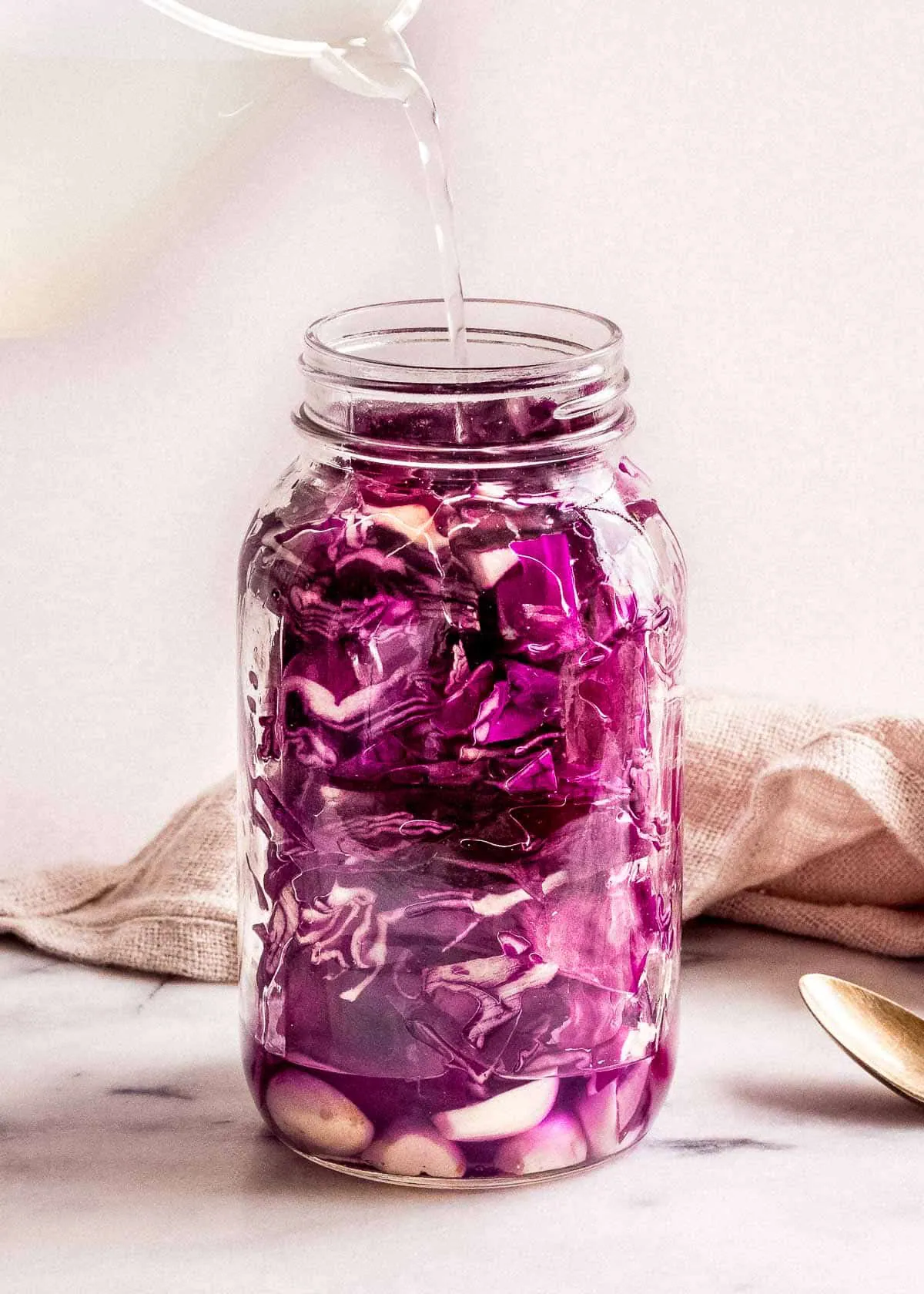
How long does it take to make sauerkraut?
In my experience, it takes about 4-5 days to ferment this red cabbage sauerkraut at home, depending on room temperature and other factors.
Leaving it to ferment longer than this is a matter of personal preference.
Just make sure it has enough brine to cover the shredded cabbage.
I've left mine up to 8 days before for a tangier flavour!
How to store
This sauerkraut should be stored in a sealed jar in the fridge.
In my experience, it will last several months (if you don't eat it all sooner).
How to eat sauerkraut
It's so tasty, you could just eat it on its own if you want!
I like to have a small amount on the side of savoury main dishes to get the probiotic benefits.
Sauerkraut goes really well with fatty meals as the tangy flavor complements them.
It's great in sandwiches, hotdogs and buddha bowls as well as on avocado toast and vegan cheese boards.
What to eat sauerkraut with
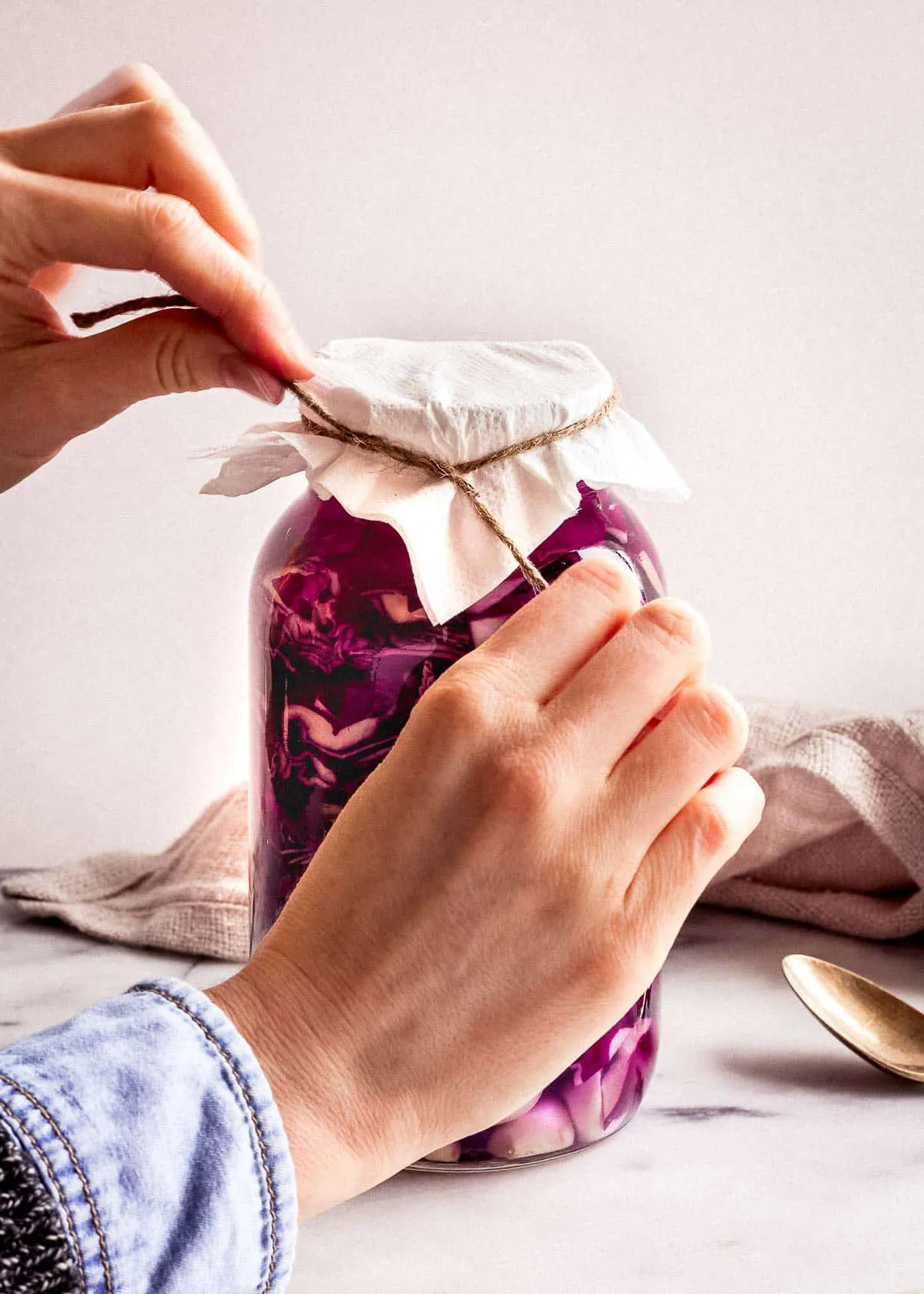
Adding flavours to red sauerkraut
Once you've grasped the basics, there are so many delicious ways to customize this fermented red cabbage recipe!
Personally, I really like adding garlic for an extra savoury taste.
But there are lots of other options such as red cabbage and beetroot sauerkraut, and red cabbage sauerkraut with ginger.
Try adding any of these:
Garlic - Peel 3 cloves, slice them in half and add to jar before cabbage.
Ginger - Thinly slice a thumb of fresh ginger and add to jar before cabbage.
Beetroot - Grate beetroot and mix with cabbage before adding to jar.
Cumin Seeds - Add 1 tablespoon of seeds to jar before adding cabbage.
Carrot - Grate carrot and mix with cabbage before adding to jar.
Tips
Choosing your salt - Make sure you use a salt that's finely ground, and not coarse.
This will make it much easier to stir into water when making brine.
Use good quality sea salt, kosher salt or Himalayan salt.
Avoiding mould - Make sure your glass jar is thoroughly cleaned before beginning, to avoid unwanted bacteria.
If any small white bubbles appear while the cabbage is fermenting, this is normal - just wipe them away with a clean paper towel.
Red or white cabbage for sauerkraut - If you're wondering what the best cabbage for sauerkraut is, it depends on your personal preferences.
White cabbage is traditionally used, but personally I prefer the taste of red, and I find it contains more nutrients (see health benefits).
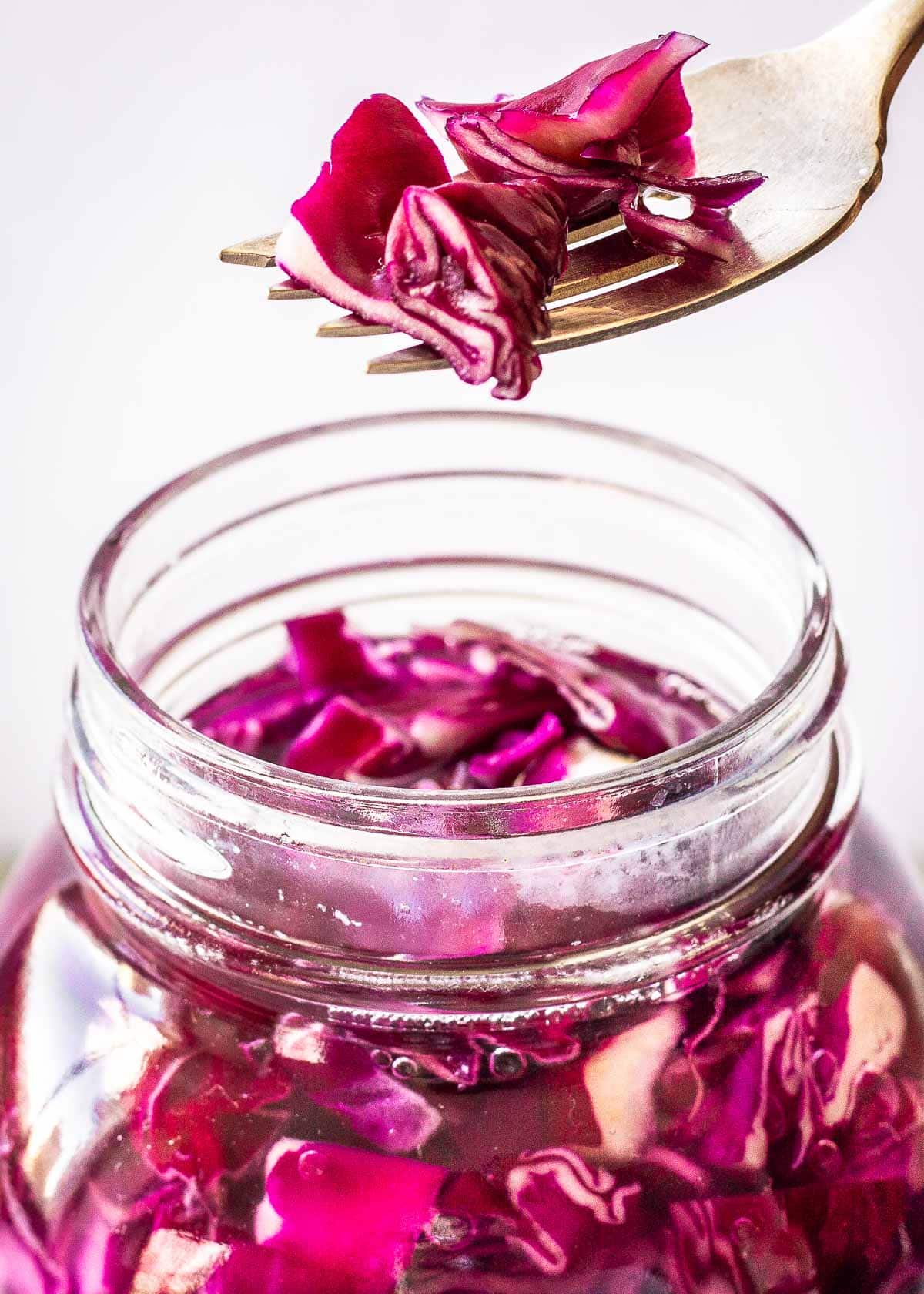
FAQs
Delicious. It's a savoury, subtle tasting sauerkraut. Generally, I find red cabbage has a less strong, spicy taste than white.
I also find it smells less, so this homemade red cabbage sauerkraut recipe is perfect even for first time fermenters!
Yes, it can have a bit of a 'cabbage-y' smell. This is a normal part of the fermentation process, but if it becomes really strong it may be a sign that you've got mould (see tip above on how to avoid it).
Usually, yes. Store-bought often tends to be pasteurized, and is sometimes made by just adding vinegar instead of using the natural fermentation process.
Although there are some exceptions to this, I find it's just easier/cheaper/healthier to make my own sauerkraut!
No. Although the flavours can be similar, pickled cabbage is created by adding vinegar, whereas sauerkraut is made through fermentation, resulting in a more nutritious food.
More How To Guides
Red Cabbage Sauerkraut (Fermented Red Cabbage)
Special Equipment
- 1 x 1 litre or 32oz mason jar
Ingredients
- ½ a large head (roughly) red cabbage
- 1 tablespoon sea salt
- 3 cups water
Instructions
- Ensure your mason jar is totally clean by sanitizing or washing it in hot soapy water.
- Set aside one piece of cabbage that's slightly larger than the mouth of the mason jar (this is what we'll use to cover the rest of the cabbage).
- Slice the rest of the cabbage thinly. Aim to make each piece similar-sized, so they all ferment at the same speed.
- If using, add any additional flavours (garlic, ginger, cumin seeds etc.) to the bottom of the jar now.
- Place the sliced cabbage in the jar, pressing it down tightly to cram as much in as possible. Fill up to the neck of the jar.
- Dissolve the sea salt in water to create a brine. Pour over the cabbage, right up to about 2cm from the mouth of the jar (you may have a little left over, that's normal).
- Fit the large piece of cabbage on top of the rest just below the water line, tucking the corners down below the neck of the jar. This will keep the sauerkraut underneath the water's surface while it ferments.
- Place a sheet of paper towel on top of the jar, securing with an elastic band.
- Leave to ferment on your countertop for 4 days, checking each day and topping up brine if any has evaporated. If a white scum appears on top of the cabbage at any point, simply scoop it off with a CLEAN spoon.
- After 4 days, sample it. If the cabbage is fermented to your taste, place a lid on the jar and store in the fridge (it will keep for several months).
- If not, leave on the countertop for a day or two longer, until desired taste is reached!
Notes
Nutritional information per serving
If you’ve tried this recipe, please leave a comment or tip for others below.
I'd love to know how you’ve made it your own!
Follow Vancouver with Love on Instagram, Pinterest and Facebook!








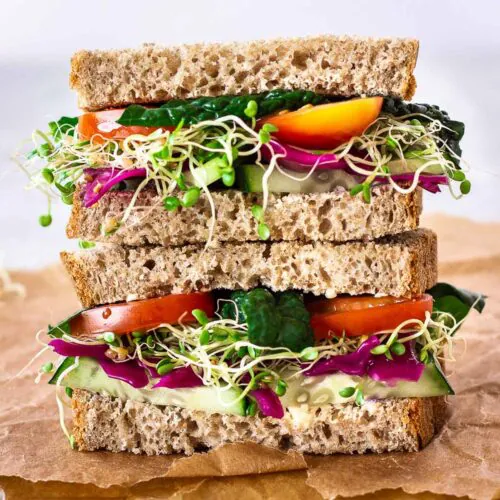
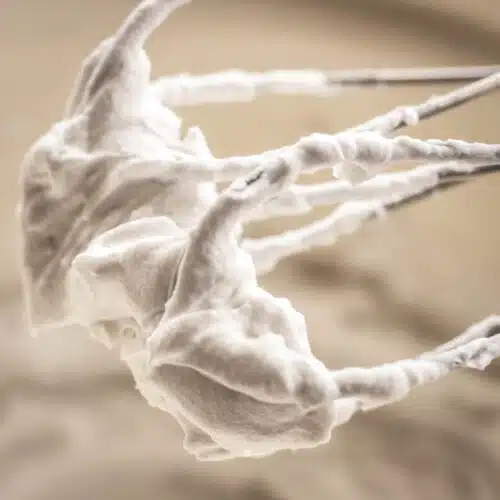

Kim
Is the garlic necessary for the fermenting, or could you leave it out and just use the cabbage and salt?
Elizabeth
Hi Kim, you can totally leave the garlic out! It's not necessary for fermenting, it was more for flavour. 🙂
Deborah
I was about to ask about the garlic as I love it and it's super healthy. Thanks for the clarification.
Elizabeth
Happy to help!
Lynn
What other veggies work well to be included with the cabbage sauerkrupt?
Elizabeth
Hi Lynn, I usually only ferment the same type of vegetables together in one jar as when I learned to make it I was told that all vegetables ferment at different speeds. You can definitely make separate jars of different fermented veggies (like carrots and green beans). If you do decided to combine different types in one jar, let me know how it goes! 🙂
Mia
Hi Lynn, can I use a glass jar with a tight lid if there’s no mason jar on hand?
Elizabeth
Yes! Any glass jar that has a lid (as it's for the fridge) should work.
Lilly
I love fermented cabbage! I use it on my salads, sandwiches, rice, and tacos. I am happy I can now make it myself instead of buying. Thanks for the recipe!
Elizabeth
You're so welcome! It's so much cheaper to make it instead of buying. And IMO it's tastier too. 🙂
Sue
Do you need to rinse the fermented cabbage before serving?
Elizabeth
No, enjoy it as is! You want the flavour and goodness it's gained form fermenting to be present.
Nancy
I LOVE red cabbage but never had it as sauerkraut. I can't wait to try your recipe. Thank you for the easy to follow instructions.
Elizabeth
You're welcome! I really hope you love it Nancy. Red cabbage makes the best sauerkraut in my opinion!
Jan
how good is pickled cabbage!!!! I am going to try this with all types of cabbage
Elizabeth
Great! This recipe is different to pickled cabbage as it uses natural fermentation. I hope you love it.
Amy Liu Dong
I have never tried to ferment my cabbage and this one look so easy and delicious!
Elizabeth
I really hope you try it Amy - it's so easy and satisfying!
Kim Beaulieu
This is such a great recipe. We've been adding the sauerkraut to everything!
Elizabeth
So happy to hear that Kim! 🙂
Lindsay Howerton-Hastings
Made a jar of this for tacos and have now been putting it on absolutely everything - it's SO good!
Elizabeth
Ah thanks Lindsay - I do the very same thing!
andrea
this red cabbage dish turned out amazing! love how healthy it is too!
Elizabeth
So glad you loved it Andrea!
Zal
Just made a bottle today. Can’t wait to taste it. Thanks for the recipe. I love fermented foods!
Elizabeth
So glad you found the recipe helpful Zal, and thank you for the comment! I love making fermented foods too. 🙂
Lorraine Blakeney
Do you need to heat the water to dissolve the sea salt or just use cold water?
Elizabeth
Cold should be fine. The salt will dissolve in it, just needs a bit of stirring!
Lily
So you leave it in the water and don’t drain it? It continues to sit in the water in the fridge?
Elizabeth
That's exactly right. A little different to the very traditional method, but I've found it keeps for several months like this.
Lily
Thank you very much 🙂